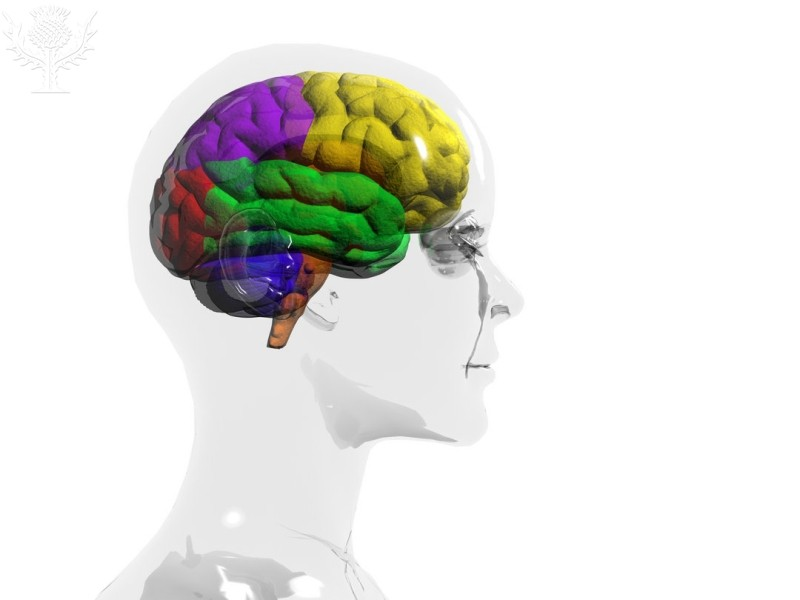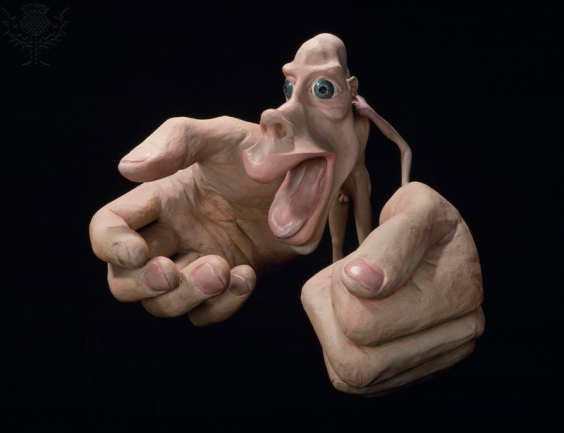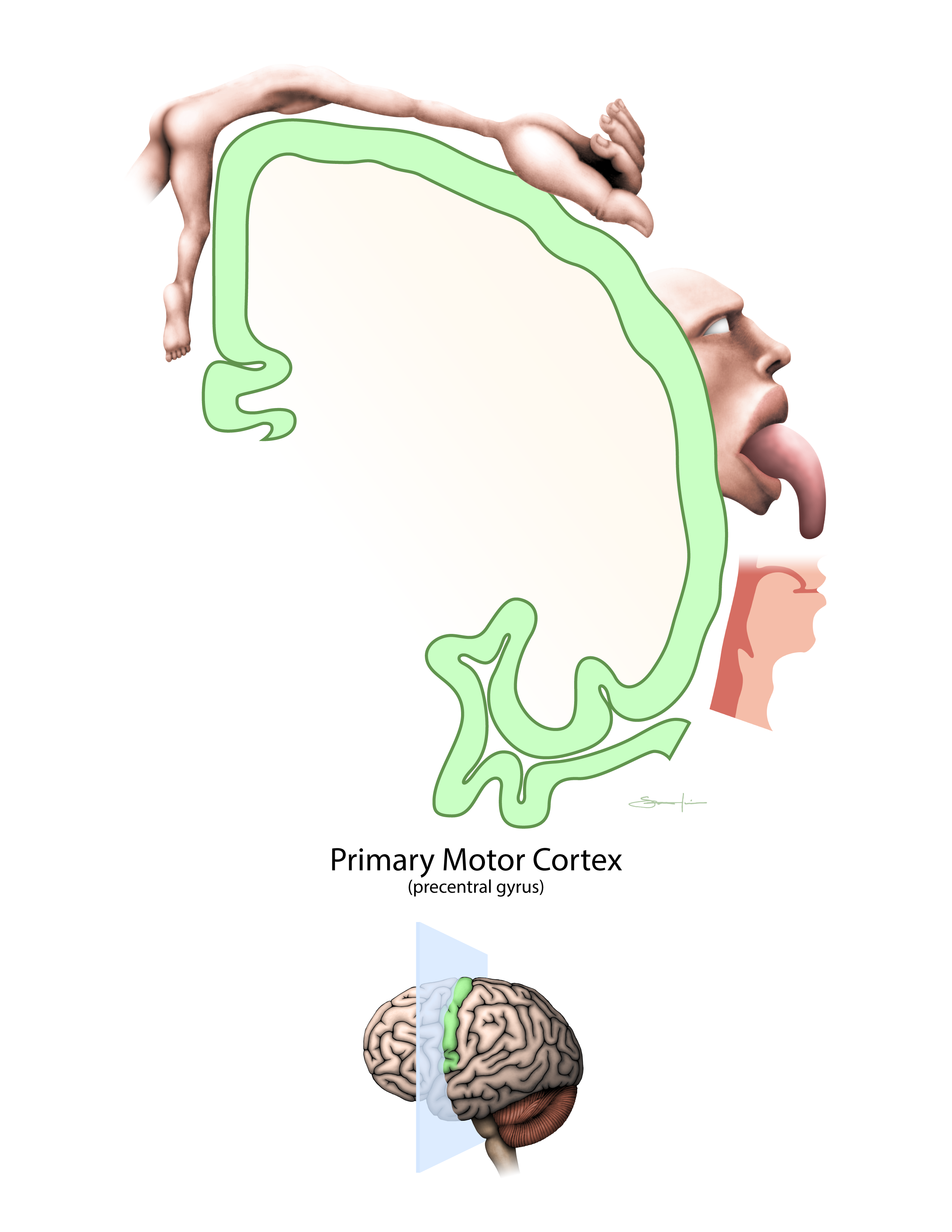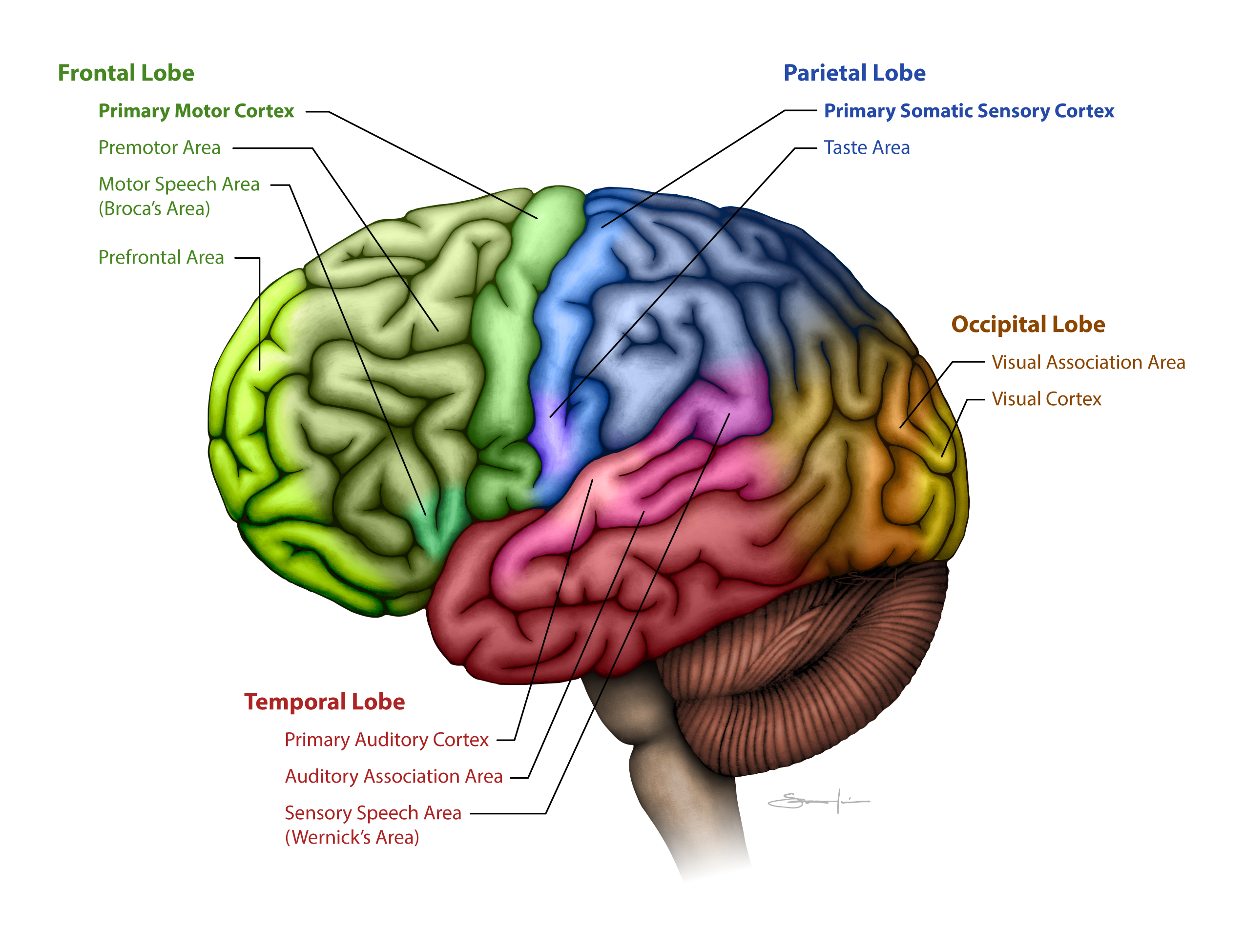The Brain
Cerebrum
The cerebrum is the largest and most superior part of the brain. It is highly developed in humans and separates man from all other species. It is divided into two hemispheres by the longitudinal fissure and each hemisphere is further divided into lobes. The classic division of the lobes is based on the cranial bones that overlay the cerebrum, hence there are four lobes, the frontal, the parietal, the temporal, and the occipital lobes. A fifth region, the insula, lies deeper in the cerebrum (Figure 2). Originally the lobes were designated solely based on their anatomical position but it is now known that each houses neurons with specific function (more on this later). In order to increase the amount of surface area the cerebrum is arranged with numerous grooves and mounds. The grooves are called sulci (singular = sulcus) and the mounds are called gyri (singular = gyrus). Note: if the cerebrum were smooth it would have to be about the size of a breach ball to have the same amount of surface area. The arrangement of the gyri and sulci is fairly consistent between individuals but there are subtle individual differences. The outer 2-4 millimeters of the cerebrum is the cerebral cortex. It is composed of gray matter, which is made up of neuron cell bodies and dendrites. Under the gray matter is the medulla which is composed of white matter. White matter is primarily myelinated axons (Figure 3).The designation grey matter comes from the observation that it looks grey in fresh brain tissue and the inner layer looks white. Other clusters of cell bodies can be found deeper in the cerebrum within the white matter. These clusters are called nuclei. Recall that a cluster of neuron cell bodies in the peripheral nervous system is called a ganglion. The various nuclei of the cerebrum make up two important functional units, the basal nuclei and the limbic system.
Let's take a minute and try to explain how the brain works. Recall that typical neurons have three main components, a cell body, several dendrites and one axon. It is often helpful to compare the nervous system to a computer network. Using this analogy, each neuron cell body would be comparable to a computer or CPU. This is where information is stored, data is evaluated, and decisions are made. In a computer network individual CPUs are connected by fiber optic cables that send information from one CPU to another. The fiber optics would be analogous with the dendrites and axons in the brain. Their job is solely to transmit information, in the form of action potentials, from one cell body to the next. As the signal from one neuron reaches a synapse it generally results in one of two possible responses, it either excites the neuron, EPSP, or it inhibits the neuron, IPSP. It is the combination of these EPSPs and IPSPs that create the code that the nervous system uses. This is very much like the binary system of ones and zeros that computers use to process information. Hopefully, it is somewhat clear that it is the cell bodies (i.e. the gray matter in the cortex and nuclei) that does all of the processing in the brain while the white matter simply carries messages from one neuron to the next. One last thing, in a computer network your CPU can connect to virtually every other CPU in the system. In the brain each neuron cell body is connected to up to 10,000 other neurons! It isn't hard to imagine how complex the brain circuitry must be.

© 2013 Encyclopædia Britannica, Inc. Downloaded from Image Quest Britannica; BYU-Idaho.
Image illustrating the major lobes and divisions of the brain. Yellow=frontal lobe, Purple=parietal lobe, Green=temporal lobe, Red=occipital lobe, Blue=cerebellum. Within the line between the yellow, purple and green is the insula. The central sulcus marks the division between frontal and parietal lobes, the lateral sulcus between the frontal and temporal lobe and parieto-occipital sulcus (only seen on the medial margin of the hemisphere) separates the temporal and occipital lobes.

© 2013 Encyclopædia Britannica, Inc. Downloaded from Image Quest Britannica; BYU-Idaho.
Histological section of a brain illustrating the grey matter (colored blue) from the white matter (colored tan).
Recall that in our analogy of the computer network the axons function to transmit information like the fiber optic cables in a computer network. Functionally, the white matter within the medulla of the cerebrum can be divided into three types of fibers: association fibers, commissural fibers and projection fibers. Association fibers connect regions within a given hemisphere allowing the right frontal lobe to communicate with the right parietal lobe, etc. Commissural fibers allow the two hemispheres to communicate with each other, hence the right temporal lobe can talk to the left temporal lobe. Projection fibers connect the cerebrum with other parts of the brain and to the spinal cord allowing information to be sent both out of and into the cerebrum.
Cerebral Cortex
The functions of the cerebral cortex include memory, attention, perception, thought, movement, language and consciousness. In other words, it allows us to be aware of ourselves, to remember names, to communicate to others and to move voluntarily. It contains billions of neuron cell bodies and dendrites, glial cells and blood vessels. Some specific functions of the cerebral cortex can be associated with the different lobes. For example, the frontal lobe is associated with motor behavior, the parietal lobe with processing and perception of sensory information. The occipital lobe is visual processing and perception and the temporal lobe processes hearing, vision, balance and language. Because of the vast array of functions, the cerebral cortex can be further divided into three generalized areas: motor areas, sensory area, and association areas.
Motor Areas: One key function of the cerebrum is control of skeletal muscle. The motor areas of the cerebral cortex control voluntary movement and are localized in the frontal lobe, they include the prefrontal cortex, the premotor cortex and the primary motor cortex. Decisions to perform a specific motor function originate in the prefrontal cortex (we will discuss other functions of this region later). Once the decision is made, information is sent to the premotor cortex. This is the staging or programing area. It must be determined which muscles will contract, what is the order of contraction, how much force each must generate, etc. for the desired movement. Once programed, signals are sent to the primary motor cortex, which then relays the signal to the spinal cord via the upper motor neurons. It should be noted that this is a simplification of the process. For example, not all upper motor neurons originate from the primary motor cortex but may also come from premotor area, or even the somatosensory cortex of the parietal lobe.
Anatomically the prefrontal cortex is the anterior-most region of the frontal lobe. Moving posteriorly the premotor cortex comes next. Finally, the primary motor cortex is the most posterior region of the frontal lobe. (Figure 5) The frontal and parietal lobes are separated by the central sulcus. The gyrus just anterior to the central sulcus is the pre-central gyrus. This gyrus houses the primary motor cortex. Neurobiologist have mapped the primary motor cortex based on which parts of the body they control and found that primary motor cortex is organized in a toe to mouth arrangement. That is, the neurons that control the lower parts of the body are at the top of the pre-central gyrus while those that control the upper parts of the body are located at the bottom of the pre-central gyrus. Additionally, the neural areas are not proportional in size in the body part that they control. Figure 4 shows the body parts superimposed on the pre-central gyrus drawn in proportion amount of brain tissue devoted to controlling them. It becomes obvious that those areas responsible for fine, intricate movement, like the hands, have much more of the primary motor cortex devoted to them than areas that principle produce more gross movements like the legs and torso. It should be noted that this upside down map of the body is not cleanly segregated and contains a considerable amount of overlap. Studies have shown that even a single neuron in the primary motor cortex can influence the activity of multiple muscles related to multiple joints. Still, the map does provide a starting point.

© 2013 Encyclopædia Britannica, Inc. Downloaded from Image Quest Britannica; BYU-Idaho.

© 2013 Encyclopædia Britannica, Inc. Downloaded from Image Quest Britannica; BYU-Idaho.
Images above are representating the proportion of the primary motor cortex that controls different regions of the body. The hands have the largest region of the brain devoted to control, the lips are next etc.
Sensory and association areas: For each of the different senses there is a region of the cortex designated for perceiving that sense. In figure 5 several of these primary sensory cortexes are labelled. The primary somatic sensory cortex is located in the post-central gyrus of the parietal lobe. This region receives sensory information from the skin and from the proprioceptors. It is therefore responsible for perceiving our senses of touch, pressure, temperature and pain, as well as informing us about the position and movement of the body. Note that the word somatic or soma means body. As is seen with the primary motor cortex, the sensory positioning of the body is also represented upside down on the primary somatic sensory cortex. Likewise, the size of the area in the brain devoted to a particular area of the body is dictated by the density of sensory receptors. For example, fingers and lips have large areas in the somatosensory cortex devoted to them compared to the torso or legs. If you want to feel the texture of an object you typically use your fingertips rather than rubbing the object on your leg! The primary visual cortex is located in the occipital lobe. It receives input from the eyes and generates images from the input it receives. The primary auditory cortex is located in the temporal lobe and converts signals coming from the ears into sounds. Not shown on the image is the primary olfactory cortex (smell) which is located at the junction of the temporal and frontal lobes (recall that the division of the cerebrum into lobes was based solely on anatomical position and not on function). Also not shown is the primary gustatory cortex (taste) which is found in the boundary between the insula and frontal lobes. Two other sensory cortexes, the primary visceral cortex and the primary equilibrium cortex are found in the insula.
Near each of the primary sensory cortexes is a sensory association area for that particular sense. As the name implies, these regions help us associate what we are currently sensing with our past experiences. For example, when you see a face, after the image is perceived in the primary visual cortex it is sent to the visual association area for recognition. Do I know this person, have I seen this face before, is this person safe or are they a threat? The association areas allow us to make sense of what we are experiencing and react appropriately.

Created by BYU-I student 2013
Diagram illustrating the general locations of sensory and association areas.
Executive Functions
We have been discussing the motor and sensory functions of the cortex, but all animals posses these regions. An important difference between humans and all other species is the development of the prefrontal cortex. This region is well developed only in primates and particularly in humans. It is this part of the brain that is responsible for what have been called executive functions. These include planning, reasoning, abstract thought, self-control, decision making, differentiation between good and bad, between better and best, and in understanding consequences to our actions. In addition it is thought that our personalities are determined by this region as well as the storage of short-term or working memory. Interestingly, this is the last region of the brain to fully develop and mature. It has been suggested that full development isn't completed until our late teens or early twenties. Did you ever wonder why you did that really stupid thing when you were a teenager? It is likely that at the time you were not completely capable of connecting the action with the consequences. Not that you can use this as an excuse but maybe we should be a bit more patient with children and teenagers, realizing that it may be beyond their capability to think the same way you do.
Lateralization of the Hemispheres
As mentioned above the commissural fibers of the white matter allow the two hemispheres to communicate with each other. Many function, like movement and sensations are carried out equally between the two hemispheres. It is true that our right hemisphere controls the left side of our bodies and our left hemisphere controls the right side of the body. Sensory information is usually shared between the two hemispheres, which allows for some interesting things to happen, like depth perception and localizing the origin of sounds. A few functions, however, seem to be restricted to one hemisphere or the other. Speech, for example, is a left hemisphere function in most people (there are always exceptions). There are two important cortical regions found in the left hemisphere that do not have counterparts in the right hemisphere. These are Broca's area and Wernicke's area. Broca's area is located in the frontal lobe (figure above) and is the motor speech area. The ability to speak and write is associated with this region. Damage to Broca's area results in the inability to speak or to write clearly. Wernicke's area is located in the posterior temporal lobe (actually exists in an area where the temporal and parietal lobes meet) and is required for understanding both spoken and written words. Damage to this region results in the inability to understand spoken or written words. If you were asked to read this paragraph out loud the following sequence of events would have to happen. Information from the eyes would reach the primary visual cortex where they would be perceived as words. This information would be sent to the visual association area for recognition of the words. A signal would then be sent to Wernicke's area for the words to be understood. Wernicke's area would then send a signal to Broca's area where the words are formulated to be spoken. Broca's area then sends the information to the premotor cortex for programming. Once the motor activity is programmed, it is sent to the primary motor cortex which relays the signals to the muscles involved in generating speech.
Other functions that seem to be more prominent in one hemisphere than the other are analytical skills, which like speech seems to be a left hemisphere function in most people. Similarly, spatial perception and musical ability are more right hemisphere functions in most people. One interesting theory was that left-handed individuals, who are right brain dominant in their motor function, should be more artistically inclined since the right hemisphere is considered the artistic side of the brain. However, studies indicate that handedness does not increase or decrease the likelihood of someone being artistically talented.
**You may use the buttons below to go to the next or previous reading in this Module**


